The Best of the Costa del Sol
There are a lot of posts out there waxing lyrically about the beauty of the Costa del Sol and telling you all the places you have to visit.
The truth is that there’s a lot of ugliness on the Costa del Sol. There are also a lot of ‘ho-hum’ places that, although nice enough, don’t warrant a flight to the south of Spain.
In this post I’ll cover:
- the main towns of the Costa del Sol (all places we’ve personally been). I’ll give you my honest opinion on each.
- I’ll tell you which you should consider as a base in the region (and which are truly worth visiting).
- I’ll also cover some interesting day trips from the Costa del Sol…because for the most part, the Costa doesn’t have many cultural/historical gems. The true gems lie inland and are some of the most worthwhile destinations you can visit in all of Spain.
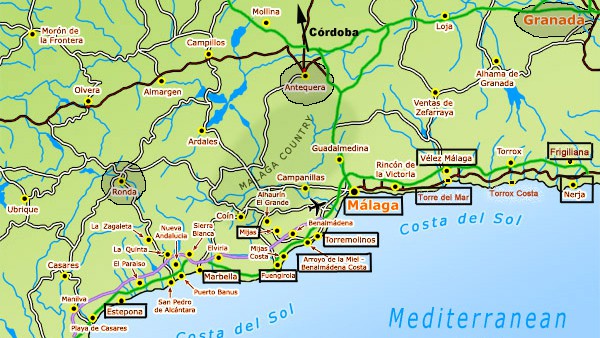
What is the Costa del Sol?
The Costa del Sol doesn’t have official, defined boundaries. The “Costa del Sol” (“Coast of Sun”) is a tourism term which, since the 1960’s, has applied to the stretch of coast in Malaga province. But it’s generally accepted that the Costa del Sol stretches from Nerja (to the east) up to Punta Chullera near Manilva (to the west). It’s a total of 150 km of coastline. The Costa del Sol extends inland along a narrow strip, including some towns and cities in the foothills of mountain ranges. I’ll cover some of these below.
The city of Malaga is the biggest city on the Costa del Sol and the center of the region. Towns to the west of Malaga have always been more popular: starting in the 1950s, Torremolinos was the first famous beach destination attracting celebrities from around the world. Development along the coast grew in the 60s and 70s to include Benalmadena, Fuengirola and Mijas while Marbella became a destination for the rich.
To this day, the coast west of Malaga still receives more tourists. It’s also more accessible – Torremolinos, Benalmadena and Fuengirola are linked to Malaga (and Malaga airport) by a commuter train line that can take them to those beach resorts in minutes (10 minutes to Torremolinos, 45 minutes to Fuengirola which is the last stop). The coast east of Malaga gets less tourists and doesn’t have the big-name resorts that the west does. But the beaches are just as nice and the inland “white villages” just as pretty.
A breakdown of the different town and cities below.

The Towns and Cities of the Costa del Sol
Malaga
The city of Malaga is by far the largest metropolitan area on the Costa del Sol. As mentioned above, people often skip it and take the commuter train line from Malaga airport to the beach resorts down the coast.
But Malaga should be visited, even if only for one day. It has a beautiful old town highlighted by the one-towered Malaga Cathedral. There is a Roman theatre dating back to the 1st Century BC and two Moorish fortresses: the Alcazaba (a fortress/palace built in the 11th century) and, up high above the city, Gibralfaro castle (built in the 14th century). The views from Gibralfaro over the city and coast are fabulous.
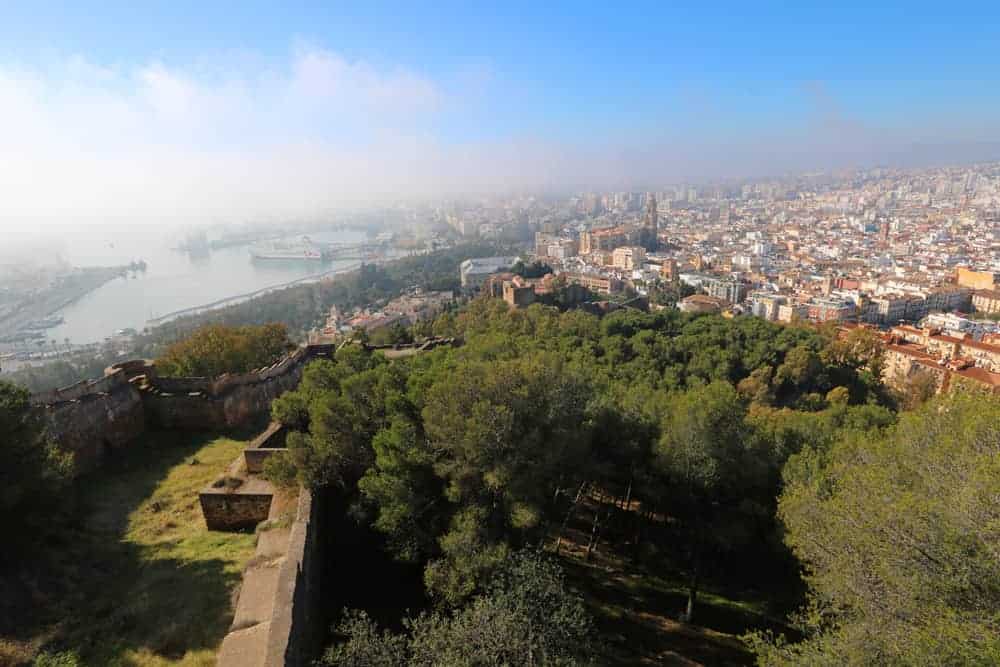

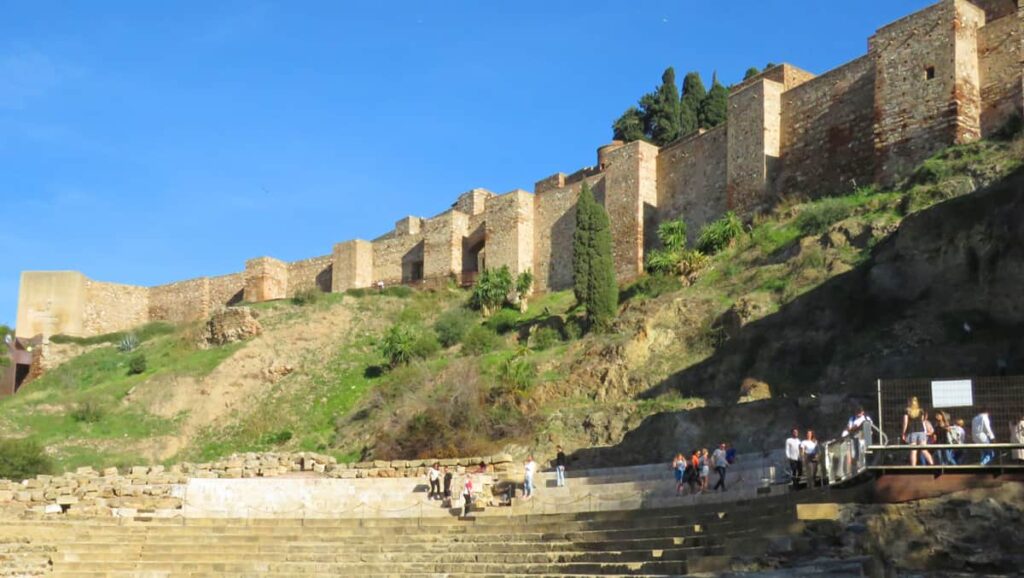
There aren’t too many historical highlights on the Costa del Sol so I would recommend a stop in Malaga for all the above.
Malaga also has a port and lots of museums for those who want a dose of culture.
More here: 24 Hours in Málaga.
Bottom line? Make it a point to visit Malaga, whether it’s as a daytrip from the beaches or as an overnight stay. It’s also the best base if intending to go on daytrips into the interior (more on that later).
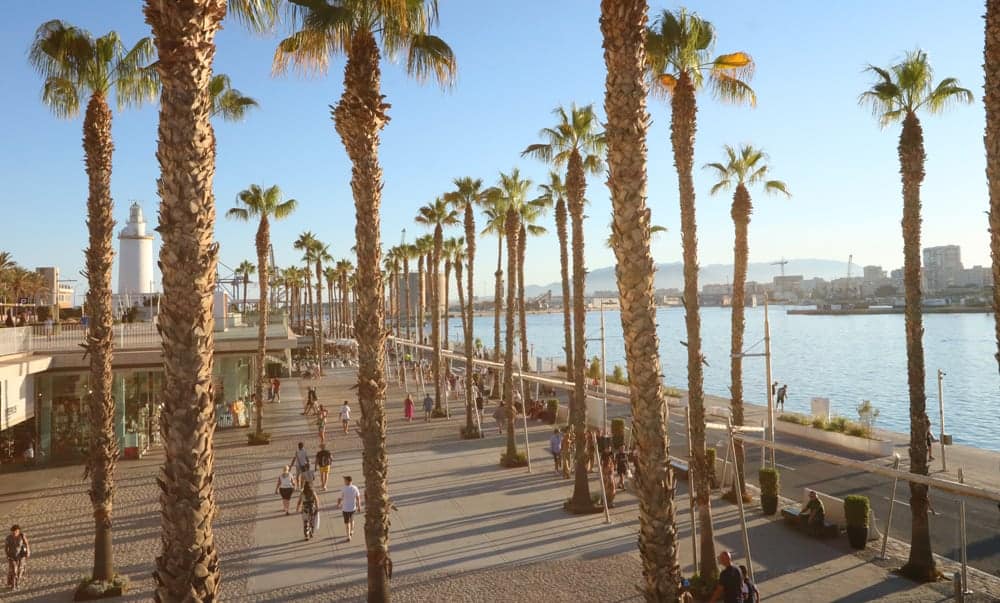
Towns/cities to the west…
Torremolinos
I’ll start with Torremolinos, the first beach resort on the Costa del Sol and a place that encompasses the best and the worst of the region.
In the 1950’s, Torremolinos attracted all the stars. People like Frank Sinatra, Marlon Brando, Grace Kelly, Eva Gardner, Orson Welles and Salvador Dali would come here. It was the place to be. Its popularity led to the continued development of the Costa del Sol.
Today it is still the most visited resort on the Costa del Sol. The highlight is La Carihuela, a 2km stretch of beaches lined with restaurants, bars and tourist stores. If you love beaches and your idea of a holiday is sitting somewhere, enjoying the sun and people-watching, then La Carihuela is perfect.
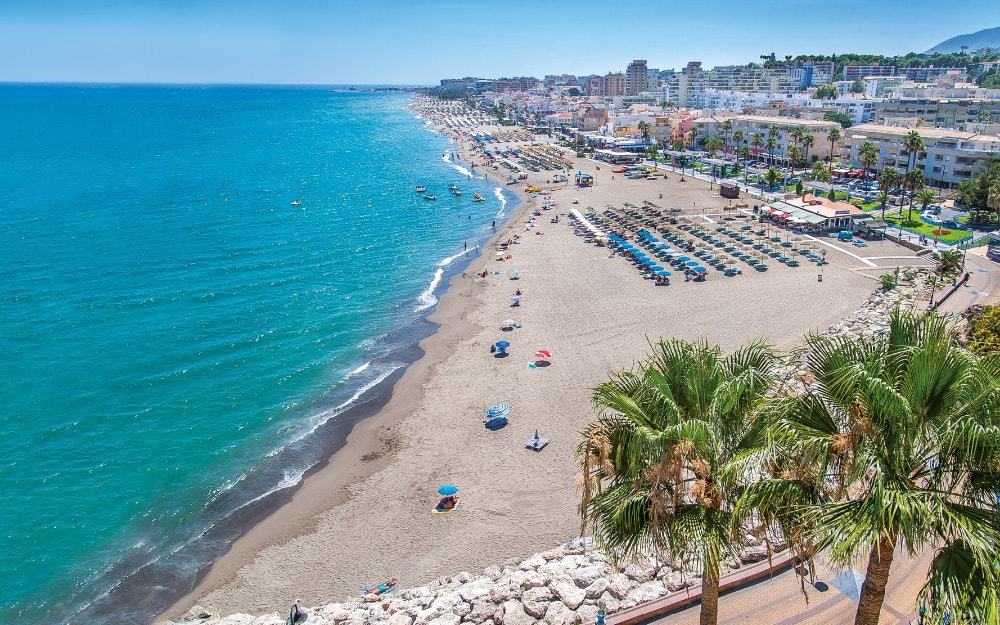
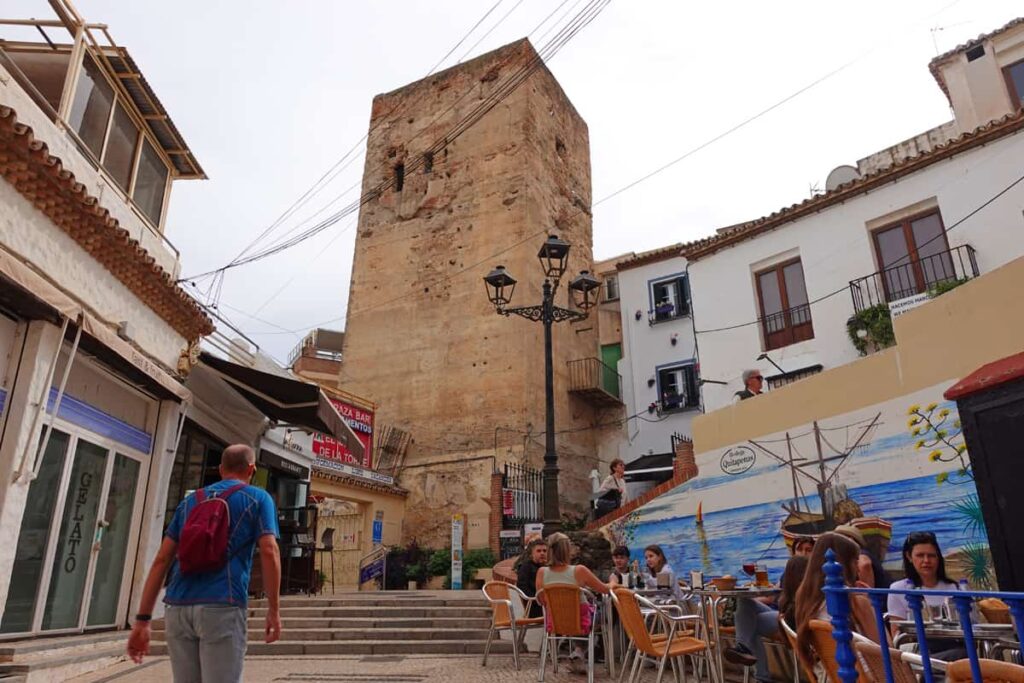
Otherwise, Torremolinos is not an attractive place at all. The town is full of the unattractive high-rises synonymous with the Costa del Sol. The old town is uninspiring.
Torremolinos is not Spain, it is a place full of tourists from every corner of the globe coming for beach, sun, drink and nightlife.
Bottom line: I don’t recommend Torremolinos except as a 1-night stay prior to flying out from Malaga airport. Hotels are plentiful, prices cheaper than in Malaga, the beaches are great, and you’re 10 minutes from the airport by train or taxi.
Other than that, give Torremolinos a miss.
More here on Torremolinos: Impressions of Torremolinos.
Below: a video on Torremolinos
Benalmadena
When people think “Benalmadena” they’re usually referring to Arroyo de la Miel or the coast.
Note: Benalmádena is divided into three main areas: Arroyo de la Miel, the Coast, and Benalmadena Pueblo. Arroyo de la Miel consists of Arroyo de Miel “old town” which is the most populated part of Benalmadena. Lots of restaurants, bars, stores and the train station (from where it takes about 20 minutes to get to Malaga). The Coast includes seaside resorts, a promenade, and Marina. Benalmadena Pueblo (the original historic old town) is about a 10-minute drive inland in the foothills of the mountains – it is a small but pretty white village with great views looking down towards the coast. It is not generally where tourists stay but has several highlights worth visiting.
Arroyo de la Miel’s (and the Coasts’) highlights are very family orientated: you’ll find Sea life Aquarium, Selwo Marina and Benalmadena’s cable car which takes you up Calamorro Mountain (lots of trails and hiking up there). You’ll find what I think is the most beautiful park on the Costa del Sol (Parque la Paloma), you can walk the promenade and go to the Marina (which is popular but which I found tourist-tacky to be honest). In Benalmadena Pueblo you’ll find Castillo de Colomares which is maybe the strangest “castle” you’ll ever see (it’s actually a monument dedicated to Christopher Columbus). The old town also has Jardines del Muro, a great setting where you get fabulous views over the coast below. Also close by are Benalmádena Stupa (the highest Buddhist stupa in all of Europe) and Mariposario de Benalmádena (a butterfly park).
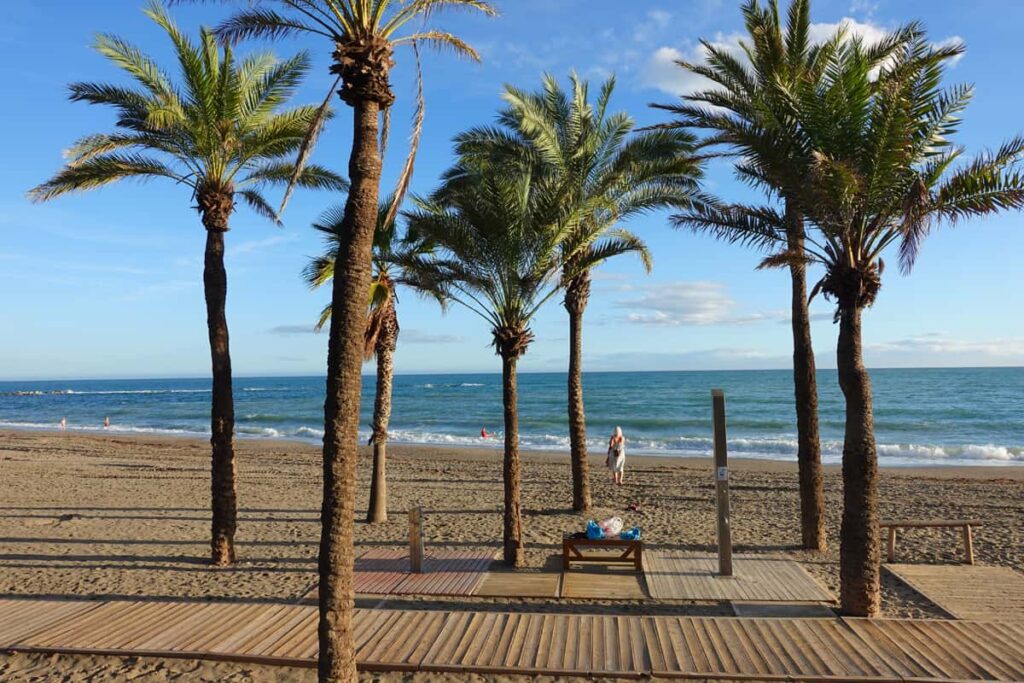
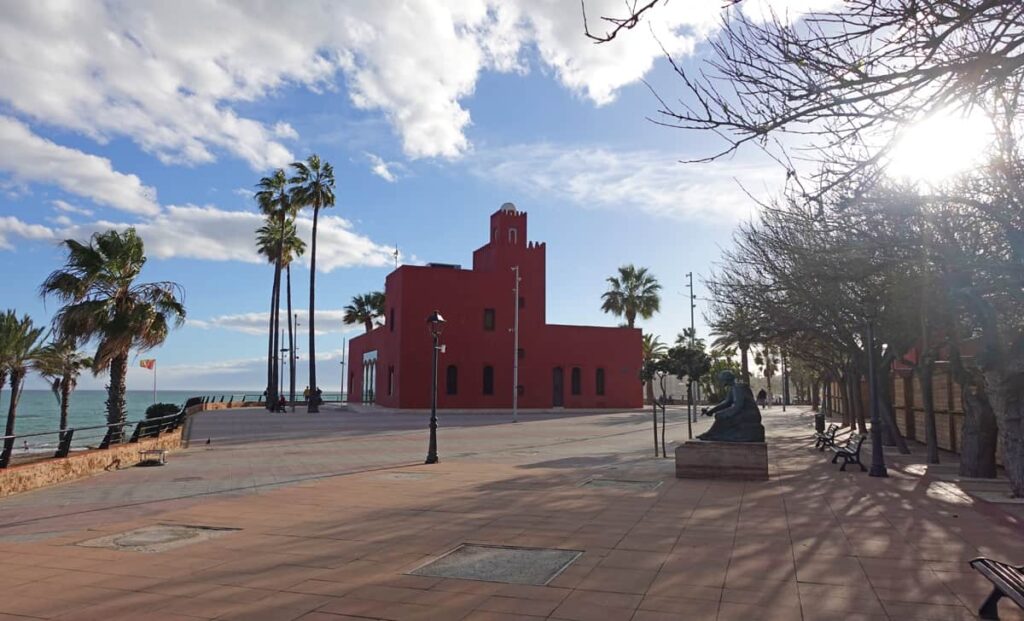

Benalmadena is worth visiting especially if you have kids and want to keep them entertained with all the various highlights I’ve mentioned above. It is clean, tourist-friendly (lots of restaurants and bars catering to foreigners), and it has the same easy access to Malaga as Torremolinos does with the commuter train. It’s a pleasant place and I see why it is so popular with both tourists and expats. And Arroyo de la Miel makes for a good base to see other places like Malaga city, Mijas and Fuengirola.
Bottom line? A good place especially if you have kids and want a relaxing holiday. It combines fun activities and nature in an attractive setting.
More here on Benalmadena: What’s Benalmadena like?
A video on Benalmadena
Fuengirola
Fuengirola is the last of the big 3 seaside towns linked to Malaga by the commuter train. It takes 45 minutes to get here from the city (35 from the airport).
Fuengirola has a much different vibe than either Torremolinos or Benalmadena. With a lot less visitors, it feels very much Spanish. People here go about their business, there are lots of stores and restaurants – it feels like a Spanish city with several busy streets and plazas. It also has a gorgeous seaside promenade which beats those in both Torremolinos or Benalmadena.
There’s not much to see in Fuengirola except for Sohail castle at the end of the promenade. So some tourists may find the town boring. On the other hand, the beaches and promenade really are beautiful and if you’re looking for a place for a relaxing beach vacation (and an authentic vibe), then you might like Fuengirola. We actually really liked the town.
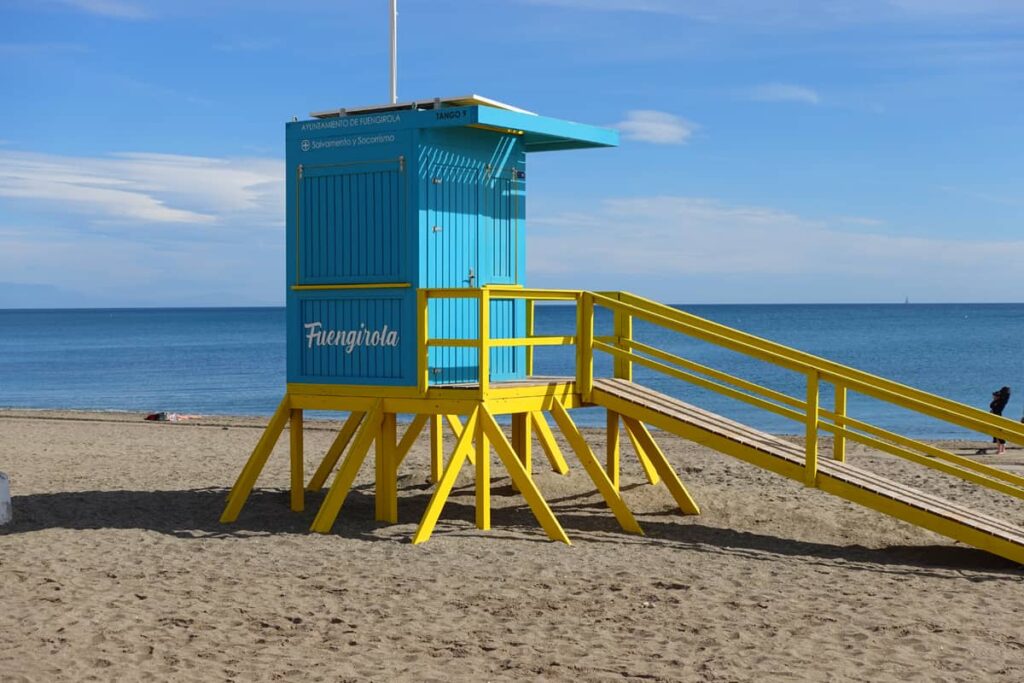
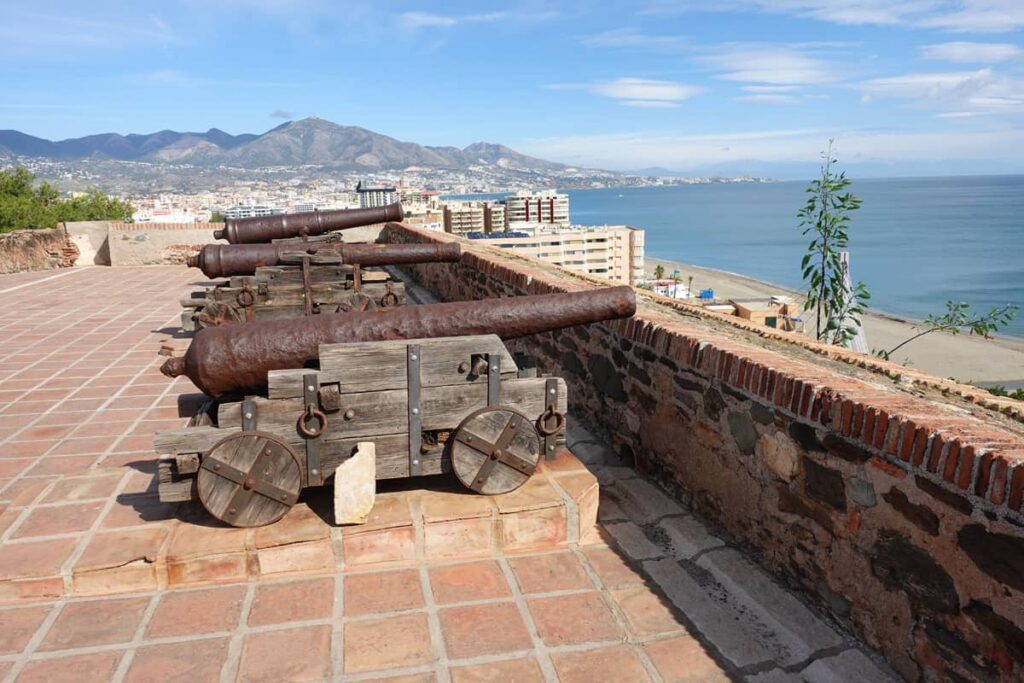

Bottom line? The most relaxing, authentic place of the big 3 resorts to the immediate west of Malaga. A place to come for a beach vacation while experiencing an authentic Spanish town vibe.
Mijas Pueblo
In the hills behind Benalmadena and Fuengirola lies what is maybe the prettiest inland town on the entire Costa del Sol.
Mijas is the typical Spanish “White Village” with its white buildings, colourful pots of flowers and pretty plazas. In Mijas’ case, you can add beautiful views of the coast, some interesting historical sites like Chapel of the Virgin Mary of the Rock (la Ermita de la Virgen de la Peña) and the ruins of the old fortress. You’ll see “donkey taxis” which I’ve never seen before anywhere.
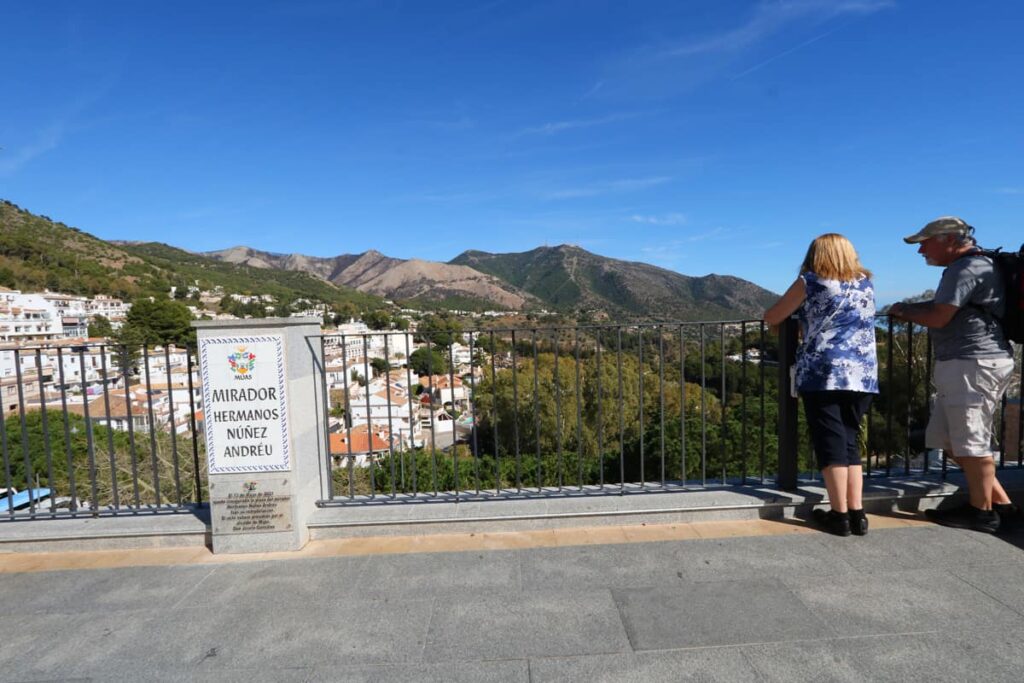
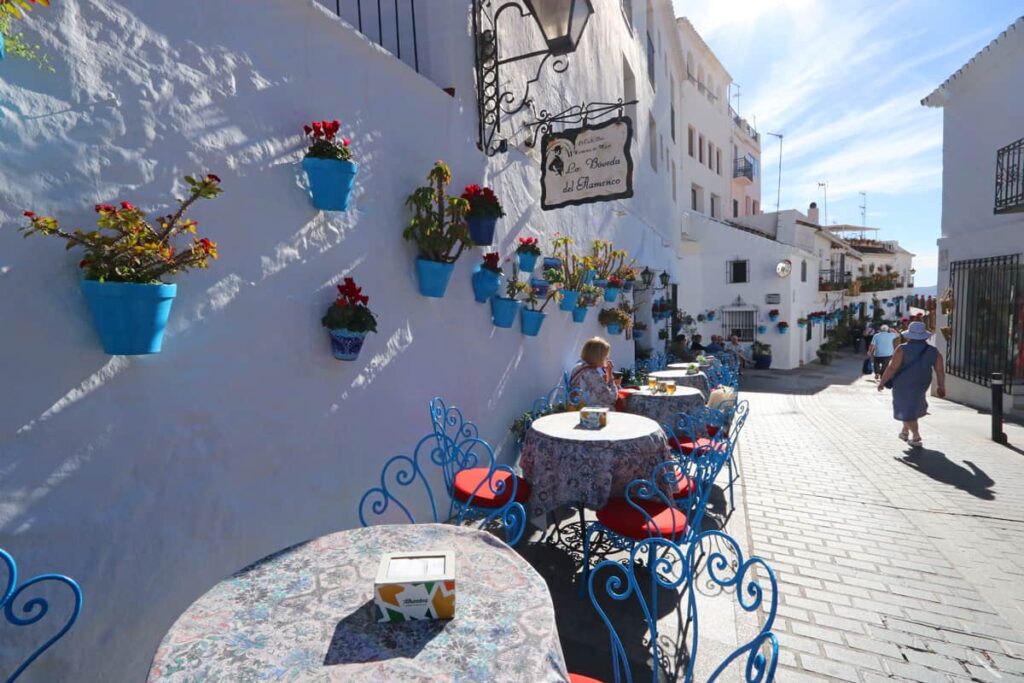

Mijas reeks in charm and prettiness. But it’s not undiscovered, you’ll see lots of tourists coming here on day trips. But it’s very much worth it.
Bottom line: come here for a day trip. Or stay a night. It’s a very pretty town and as far as I’m concerned the most interesting of the White Villages on the Costa del Sol. Note: this tour from Malaga includes Mijas and Marbella.
More: Is Mijas Pueblo Worth Visiting?
Below: a video on Mijas Pueblo
Marbella
I’ll admit to having preconceived thoughts on Marbella as a glitzy, exclusive and somewhat artificial place. That does exist but that’s mainly in Puerto Banus which is about 10 km away (and which we found very boring).
But the town of Marbella itself is gorgeous and historic. Of all the coastal towns on the Costa del Sol (except for Malaga), we found its old town to be the most intact and interesting. You’ll see beautiful churches, plazas with fountains, old fortress walls, tons of little streets lined with plants and flowers. There’s a street full of Salvador Dali statues that leads to a long beach promenade.
Marbella is beautiful.

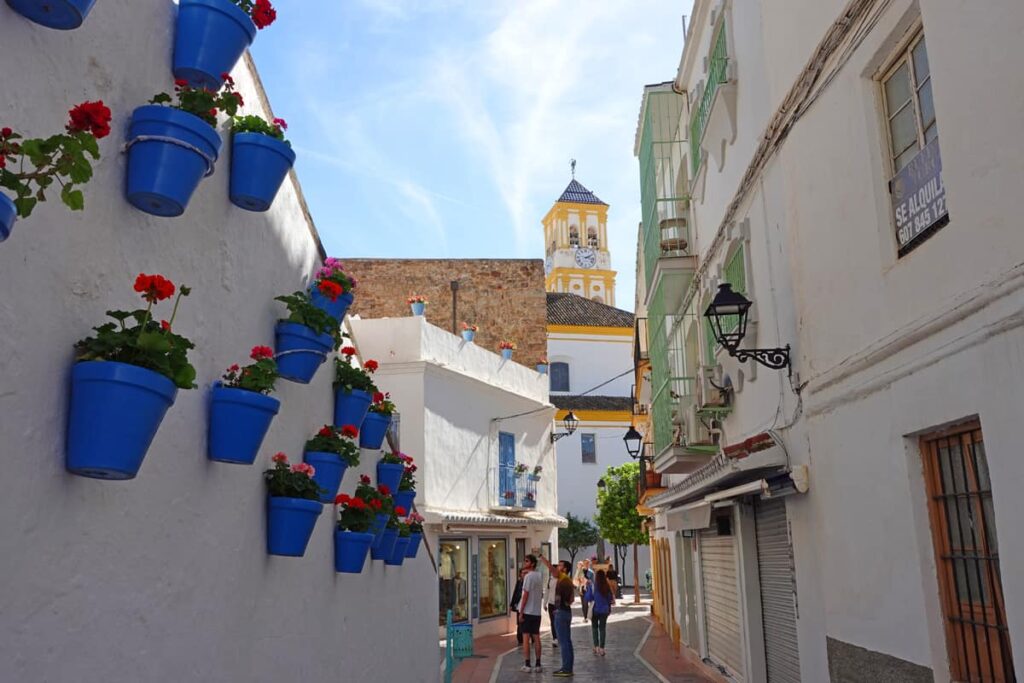
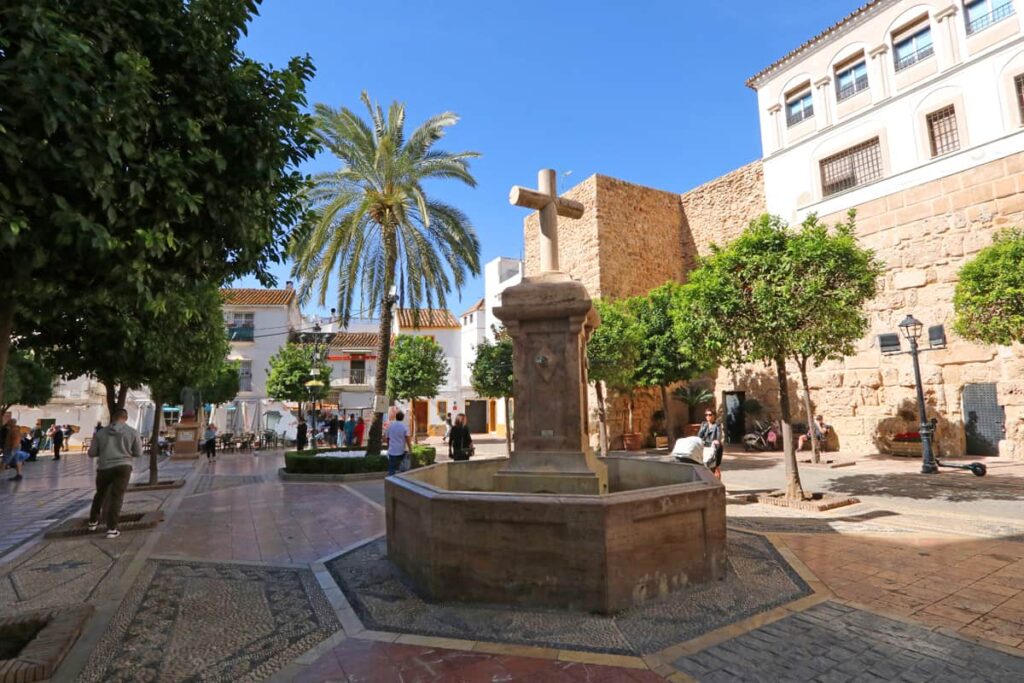
And Marbella doesn’t have to be expensive: we stayed in an apartment 10 minutes outside the center which wasn’t more expensive than what we paid anywhere else on the Costa del Sol. There we ate at a local restaurant where we had a 4-course Menu del Dia which cost 15 Euros.
Bottom line: we ended up falling in love with Marbella. As I say, the most beautiful old town along the coast excepting Malaga. It’s also handy-sized: you can walk the old town then stroll down to the promenade and enjoy the beaches. Everything is close by.
A video on Marbella
Estepona
30 minutes down the coast from Marbella is Estepona.
I joked to Lissette that Estepona must have an army of horticulturists – I’ve never seen a place so full of plants and flowers as Estepona. Colourful pots line all the streets of the old town, each in their own colour scheme. The promenade is literal a botanical garden of trees, bushes and exotic flowers. It’s unbelievable.
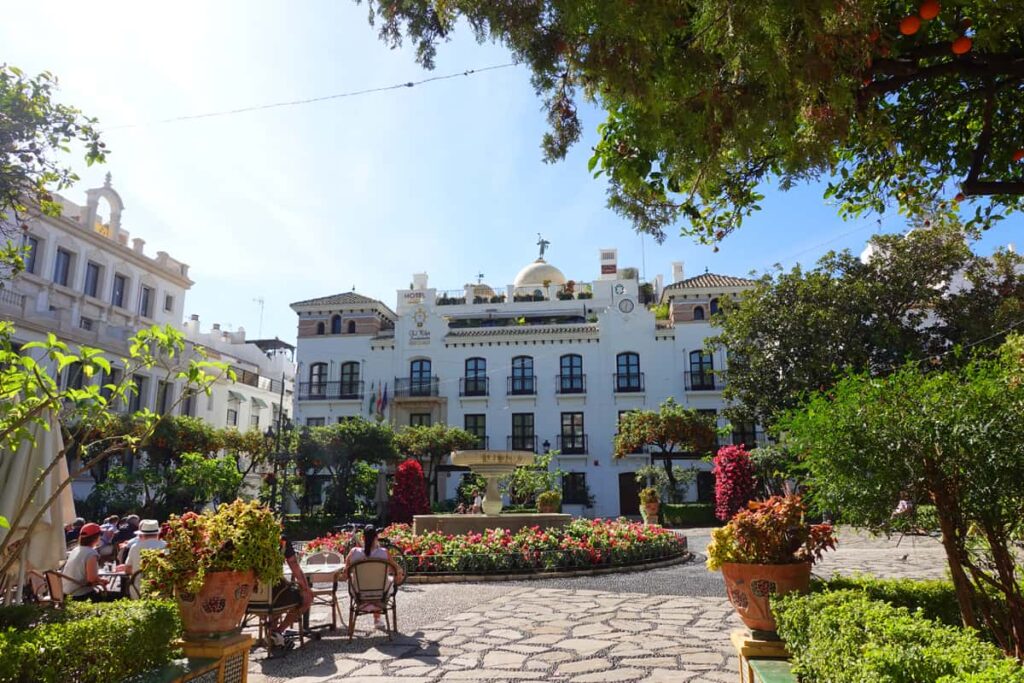
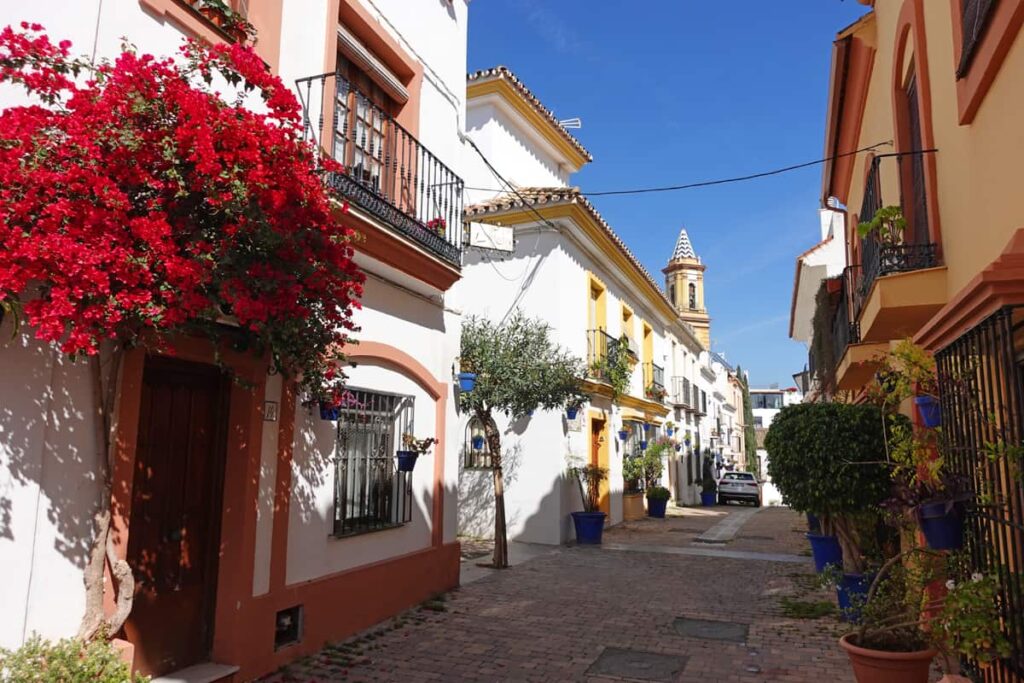
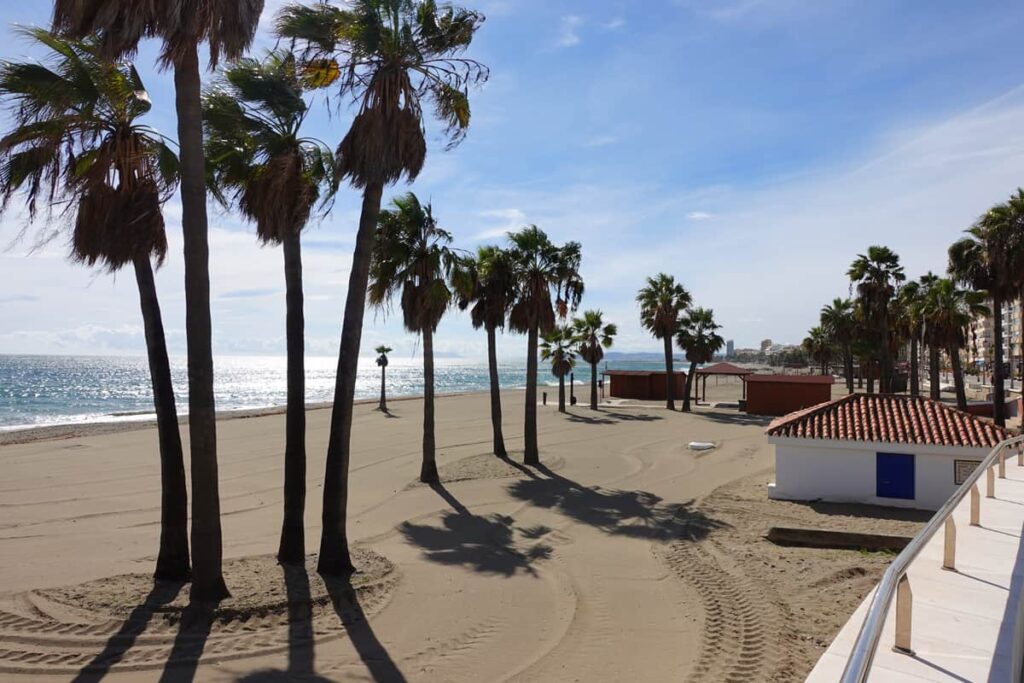
Although good sized, Estepona’s old town doesn’t quite compare to Marbella’s old town in its attractions. But it’s infinitely prettier than that of Torremolinos, Benalmadena or Fuengirola.
What really sets Estepona apart are its beaches (long, wide sandy beaches) and beautiful promenade which winds down the coast. Estepona is a pretty place.
Bottom line: If I wanted a beach vacation west of Malaga city, Estepona would be the place. It is a relaxed, pretty place that has quite a large expat population but which still feels authentically Spanish.
A short video on Estepona
Towns/cities to the east of Malaga…
Nerja
Nerja is the star destination east of Malaga.
Nerja has a pretty old town, lots of beaches, and is a great spot for restaurants and nightlife. Outside of town, you have the Nerja Caves which are a geological wonder and you can go hiking in the Sierras de Tejeda, Almijara and Alhama Natural Park. Frigiliana (which I’ll cover below) is just 10 minutes away. There’s lots to do in Nerja.
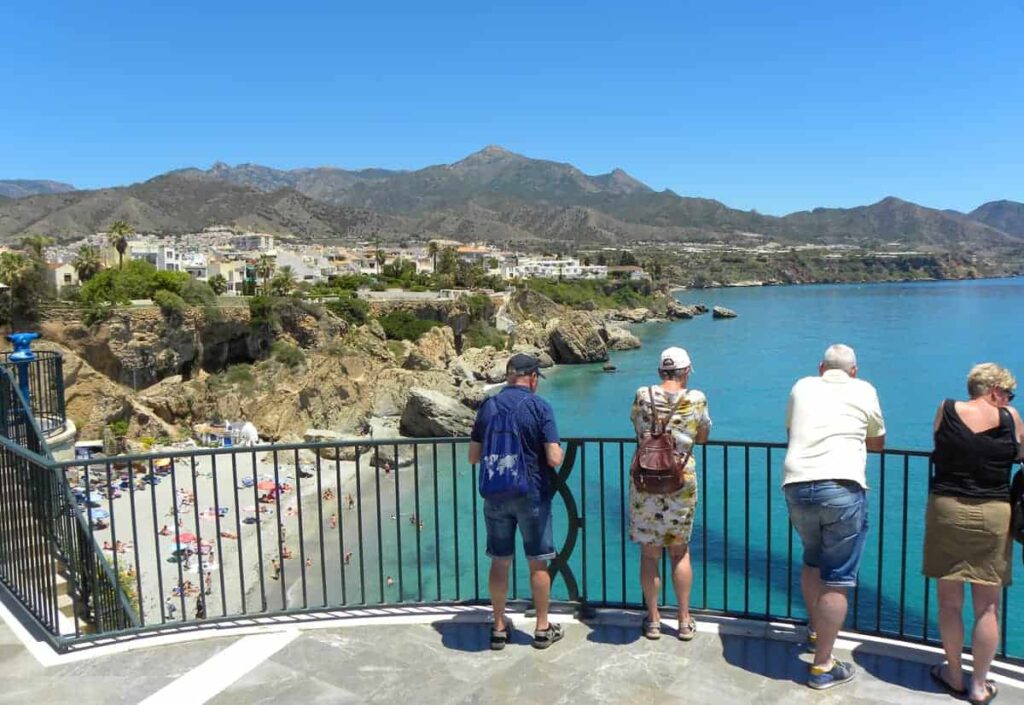
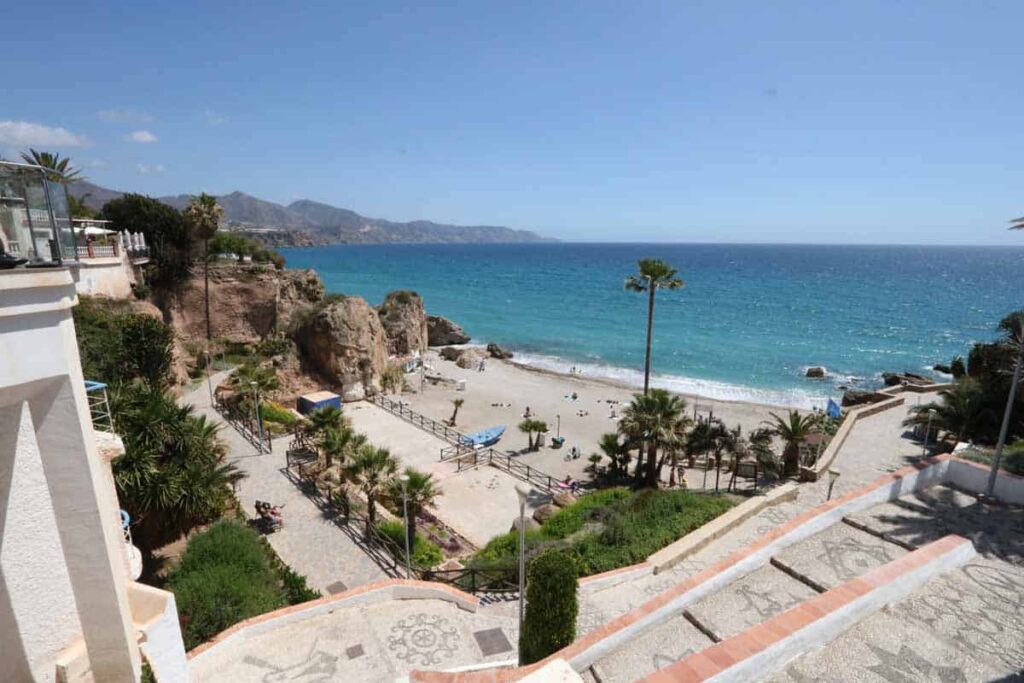
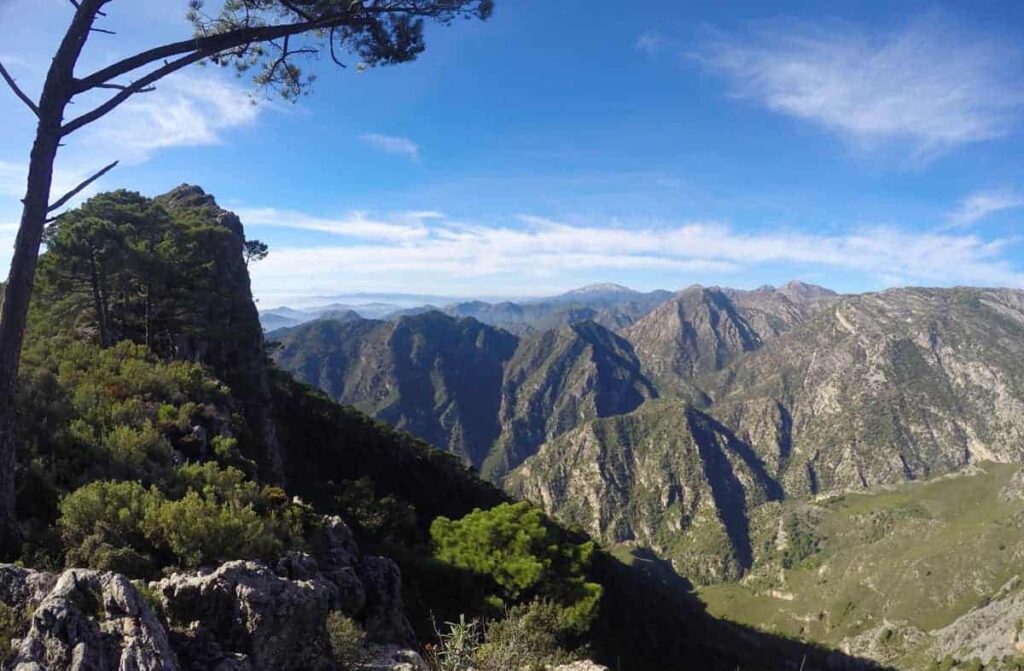
Bottom line: Nerja makes for an excellent vacation destination with enough to keep you busy for a few days. Of all the places east of Malaga, it has the best combination of beaches/attractions and dining. The one thing I’ll mention: of all the coastal towns I’ve listed, Nerja’s beaches generally require you to go downhill or down steps to get to. Important to know if you have mobility issues.
A very detailed post here: The best things to see and do in Nerja
A walking tour of Nerja
Frigiliana
Frigiliana is another of those White Villages that are worth a visit.
Just 10 minutes from Nerja, it’s a small town of 3000 people built on a hillside. It’s a picturesque place of cobblestone streets full of plants and flowers. Walking through the town you’ll come across an old fountain, a church and lots of plazas offering great views over the countryside.
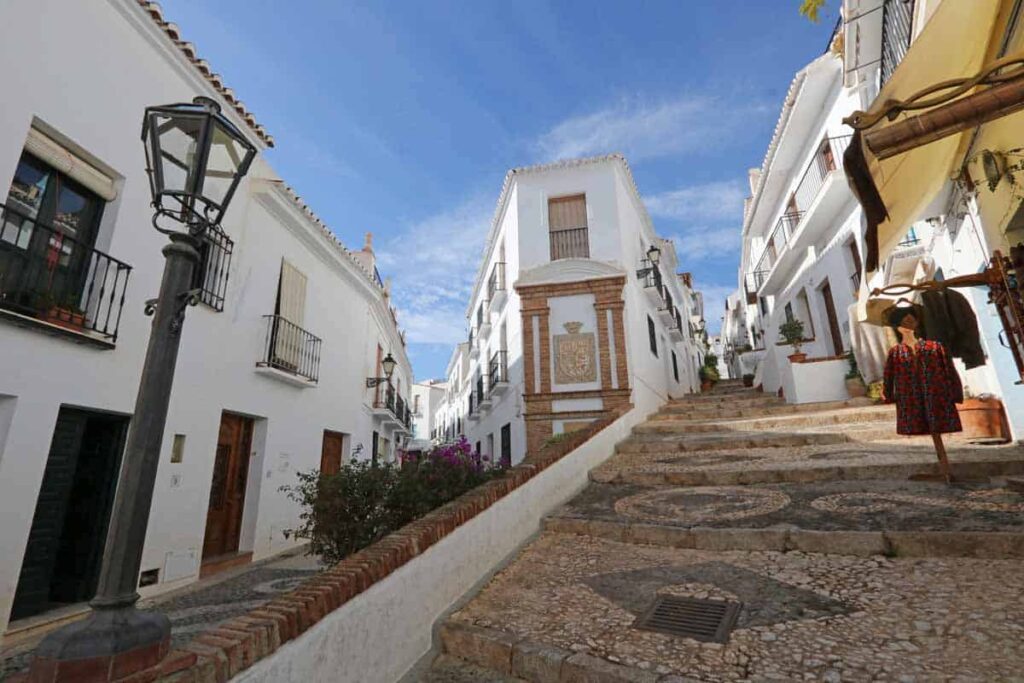

If looking for a relatively easy hike, El Fuerte is right behind town.
Bottom line: If you go to Nerja you should visit Frigiliana. It’s worth the half day of walking around this pretty town.
More on Frigiliana: A Visit to Frigiliana
A video on Frigiliana
Torre del Mar
Torre del Mar has some of the best beaches anywhere on the Costa del Sol. I think they’re definitely the best east of Malaga.
The beaches are long, wide and clean. There’s a 3 km long promenade where you can hike, jog or bike (there’s a dedicated bike path).
The town itself is nothing special but it’s very clean with a good selection of stores and restaurants.
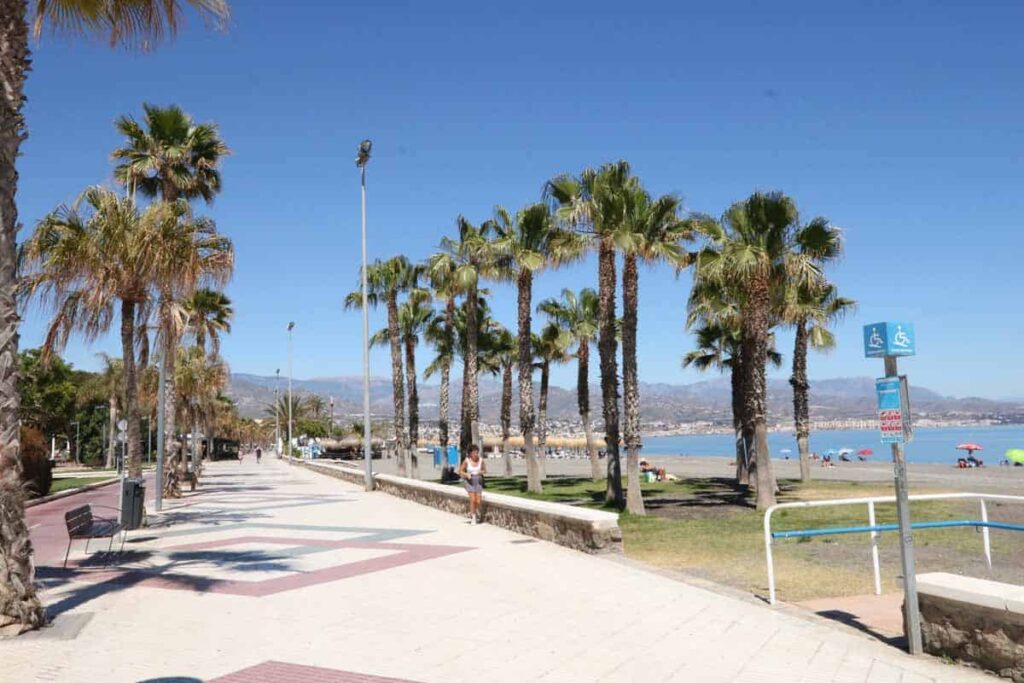
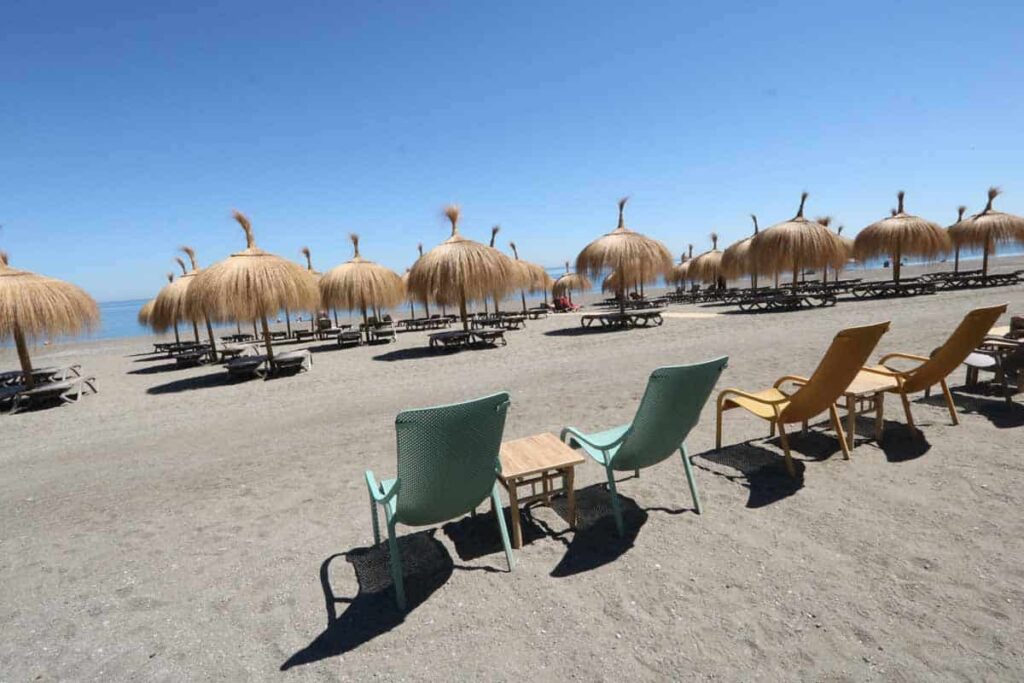
For someone looking for a beach destination without all the tourists you’ll find in Nerja, Torre del Mar is a good alternative. It’s also only 45 minutes from Malaga. And it’s about 15 minutes from Vélez-Málaga, a city that gets very little recognition for its cultural and historical highlights.
Bottom line: The best beach destination east of Malaga and still authentically Spanish.
A short video on Torre del Mar
Vélez-Málaga
Inland from Torre del Mar and in the foothills of the mountains, the city dates back to the Visigoths (around 8 BC) and was later occupied by the Romans and the Moors.
Vélez-Málaga gets little tourism which is a shame because it has lots to see: several impressive churches, museums such as Casa Cervantes (dedicated to Spain’s most famous writer), city walls built by the Moors, and a fortress atop the city offering great views.
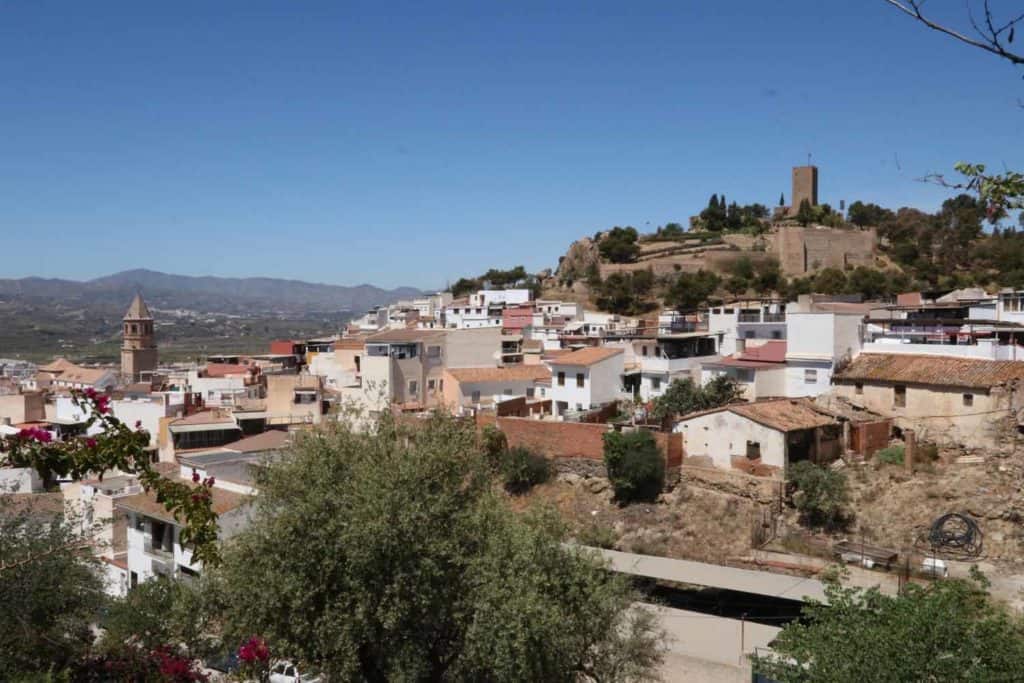
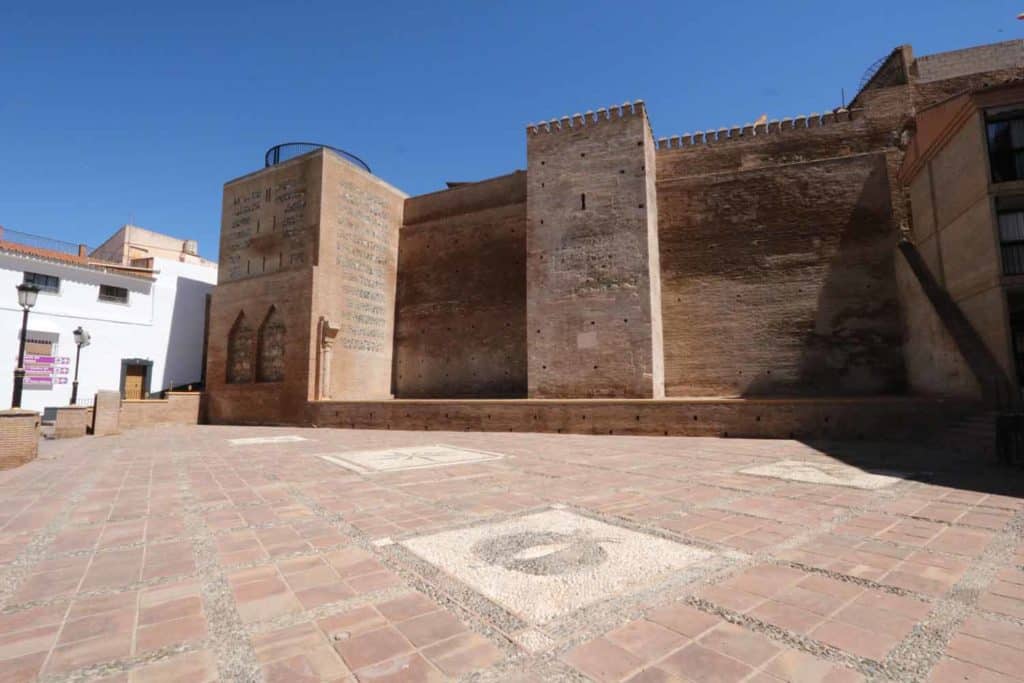
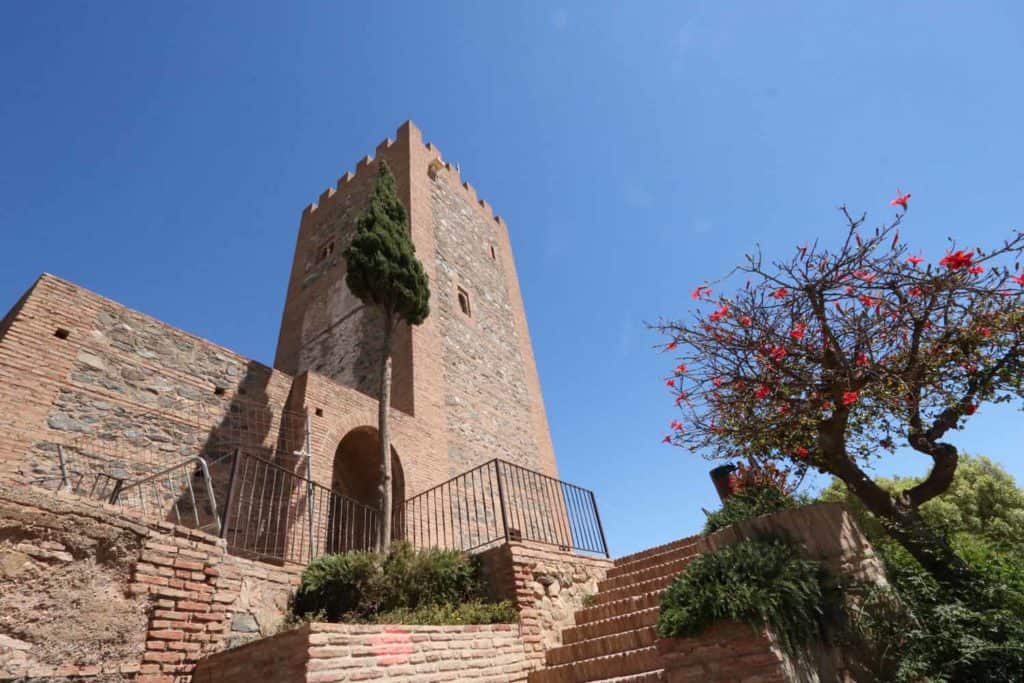
If you are tired of beaches, you can easily fit a day of sightseeing in Vélez-Málaga.
Bottom line: Vélez-Málaga is the sister city of Torre del Mar, the two being just a few kilometers from each other. If in Torre del Mar you have to visit Vélez-Málaga.
More: 30 Photos that will make you want to visit Vélez-Málaga
A video on Velez-Malaga
The best of all the towns and cities of the Costa del Sol
It of course depends on what you’re looking for out of a holiday. But if it was me, I’d consider these as bases for a Costa del Sol holiday:
Malaga city. For its history, culture, beaches and easy access to other destinations (see my section on the best Day Trips from the Costa del Sol Below)
Marbella. For its beautiful old town and beaches.
Nerja. For its mix of pretty old town, beaches, and surrounding natural highlights.
Estepona or Torre del Mar. For a relaxing beach holiday.
Mijas Pueblo. Not necessarily as a base…but it’s the prettiest white village on the Costa del Sol and should be visited.
The Best Day Trips from the Costa del Sol
Some of Spain’s greatest cities lie within an hour to 90 minutes from the Costa del Sol.

Granada
Granada is worth much more than a daytrip, but if you can only afford one day then you have to go there just to see the Alhambra. It’s one of Spain’s Top 5 attractions.
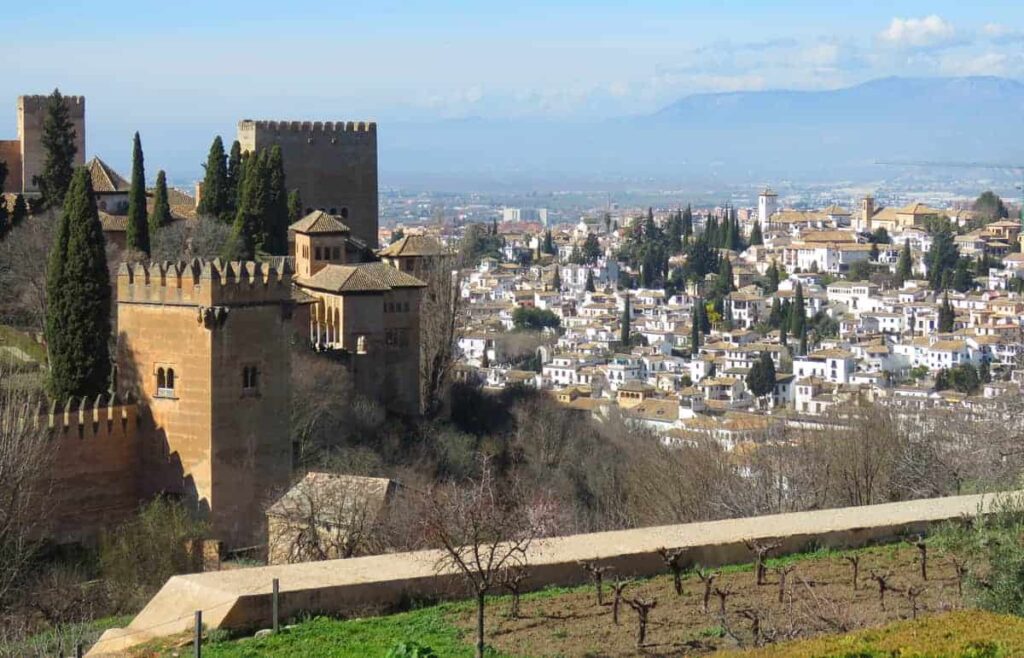
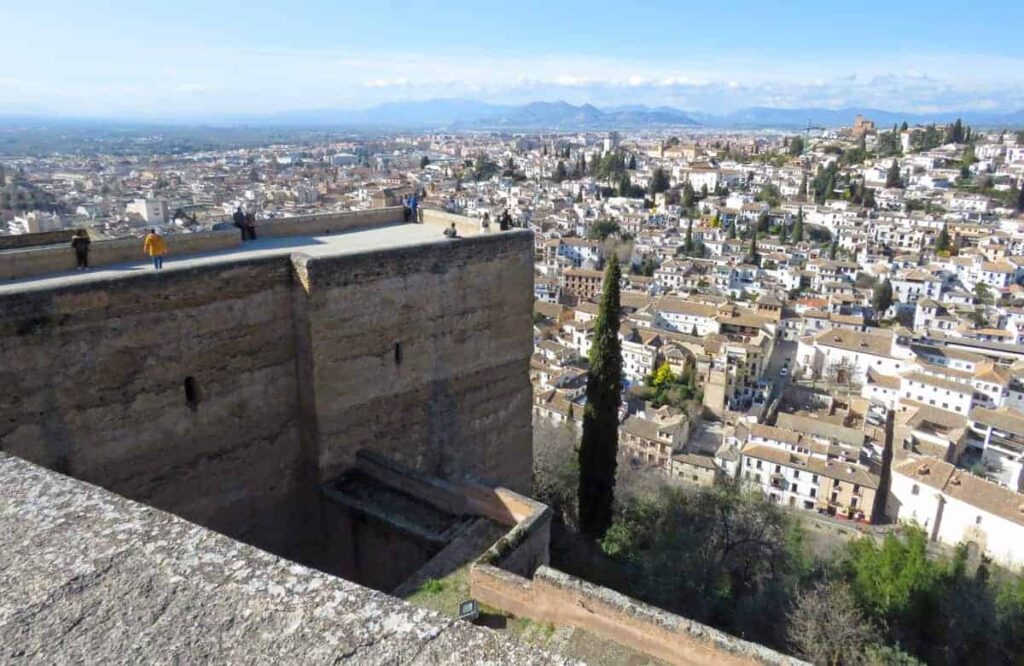

The Alhambra was the last stronghold of a great Muslim empire that at one point included most of Spain and Portugal. Like other Moorish sites (such the Real Alcazar in Seville) it is characterized by lavish architecture and sumptuous gardens. In 1492 the Moorish sultan surrendered the city to the Catholic monarchs (Ferdinand II of Aragon and Isabella I of Castile) who took up residence here. It was in the Alhambra’s Hall of the Ambassadors that Christopher Colombus signed a contract with the monarchs (in April of 1492) that would lead him to his discovery of the Americas.
Besides the incredible architecture you’ll find throughout the palace, the Alhambra is a fortress built overlooking the city. The views are incredible.
More: 48 Hours in Granada
Getting there: The high speed train gets here from Malaga in about 1 hr and 20 minutes. Or you can take the bus, about 90 minutes from either Nerja or Malaga. Or arrange for a tour: This tour from Nerja, this tour from Malaga.
Córdoba
Córdoba was the most important Islamic cities in the first centuries is Islamic rule, becoming the capital of the Caliphate of Córdoba, the Islamic state that at its height controlled much of the Iberian peninsula.
It’s an incredible city full of sights…but the highlight attraction is the “Cordoba Mosque Cathedral” (the politically correct name. Most people simply call it the “Mezquita”). It’s a large mosque covering an area of 120 square meters, making it one of the largest mosques in the world. In its center, a Cathedral was built following the reconquest of Córdoba by Christian forces.
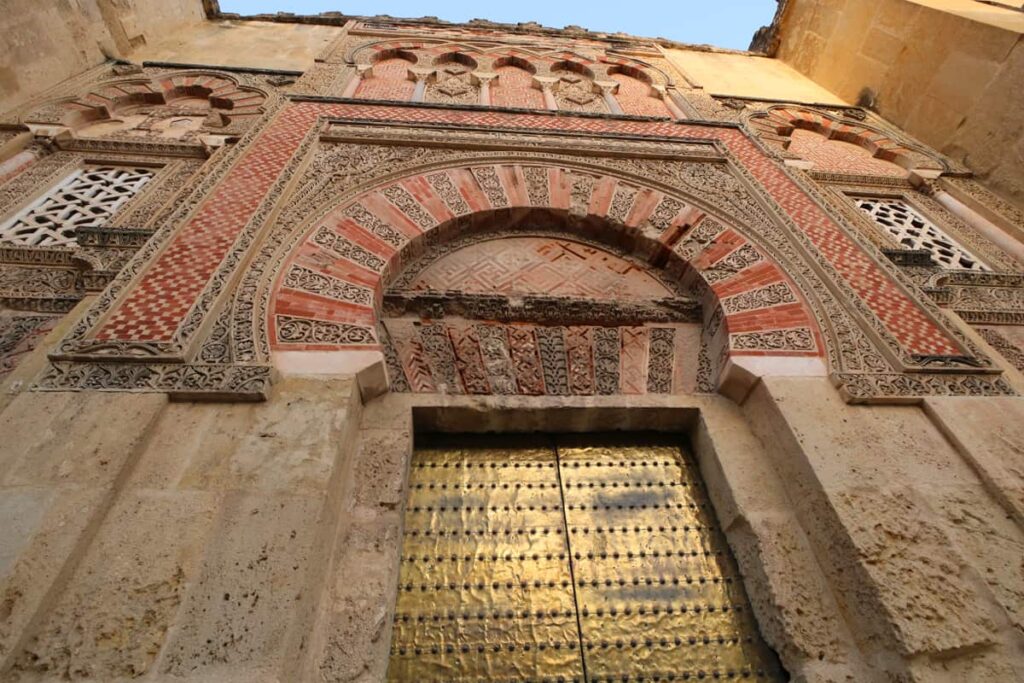
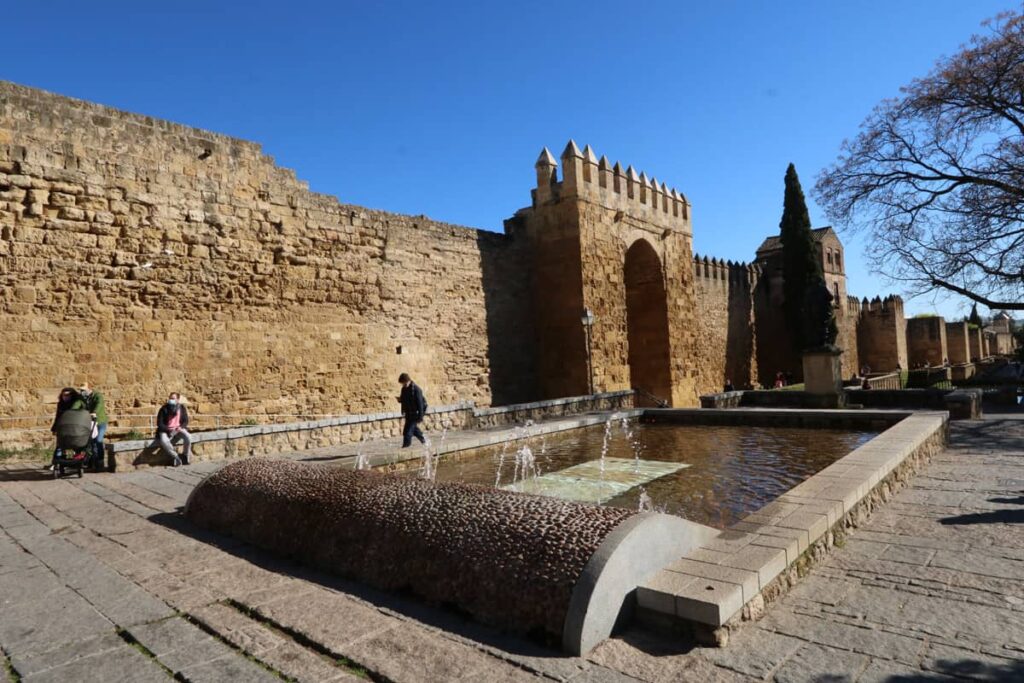
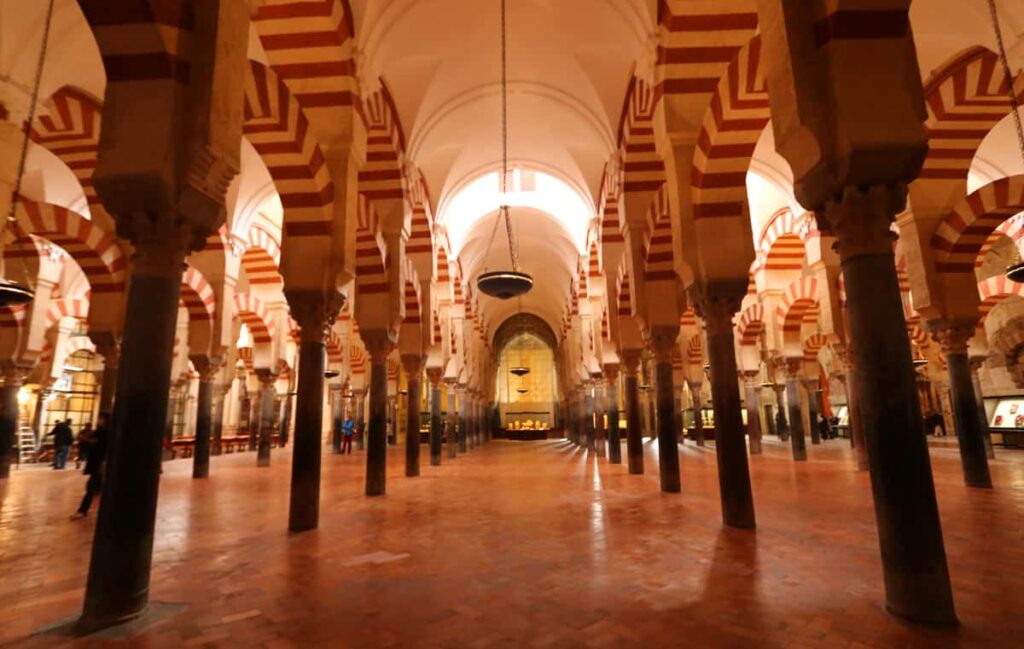
We’ve seen lots of incredible sights in Spain, but Córdoba’s Mezquita is the most stunning thing we’ve seen.
Again, Córdoba deserves more than a day. But if you only have a day it can be done by daytrip. You can take a highspeed train from Malaga, it will get you to Córdoba within an hour. Or you can take this tour from Malaga.
Ronda
It’s one of the most popular daytrips from the Costa del Sol.
Ronda is famous for the bridge connecting the two parts of the old city. Built in the 1700’s, it was a technological marvel at the time and is still stunning today.
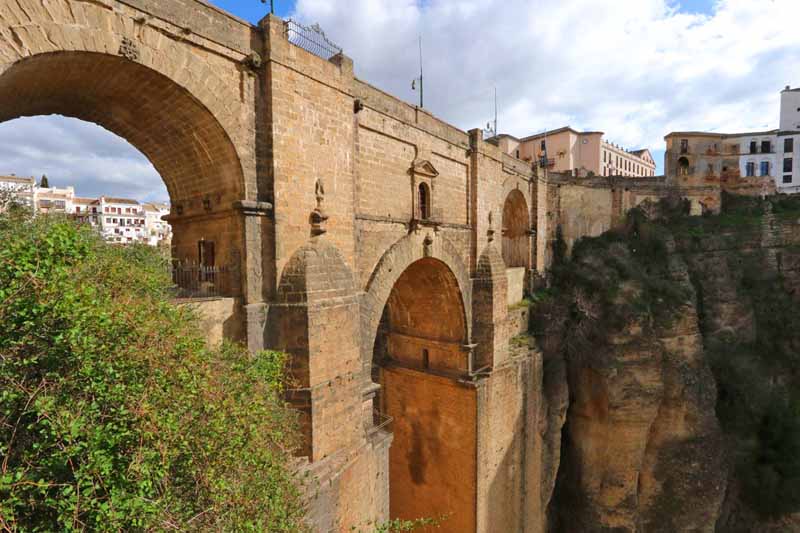

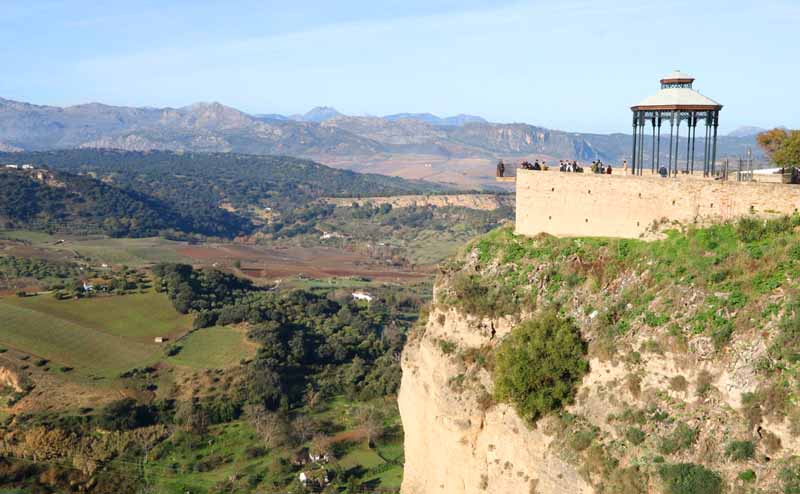
But there’s a lot more to Ronda including medieval walls, churches, towers, a deep gorge, gardens and lots of incredible views.
More here: A Do-It-Yourself walking tour of Ronda
Unlike Granada and Córdoba, Ronda can quite easily be covered within a day. Follow the instructions in the post I’ve attached above.
Getting there: take the Avanza bus from Marbella, it’s take about 1 hr, 20 minutes. From Malaga, take the Damas bus. That takes about 2 hours. You can also take this tour from Malaga that includes both Ronda and Sentenil de las Bodegas.
Antequera
I’m surprised that Antequera falls under the tourist radar. I think it’s a spectacular city with lots to see.
Highlights include a Moorish fortress sitting on top of the city. The views over the city are fantastic (try to visit on a Tuesday afternoon between 2 – 6 Pm when it’s free). The Dolmens are the most famous attractions in Antequera. Dating back almost 6000 years, these Dolmens (stone-made tombs) are one of the most important dolmen groups in all of Europe (more on that here).

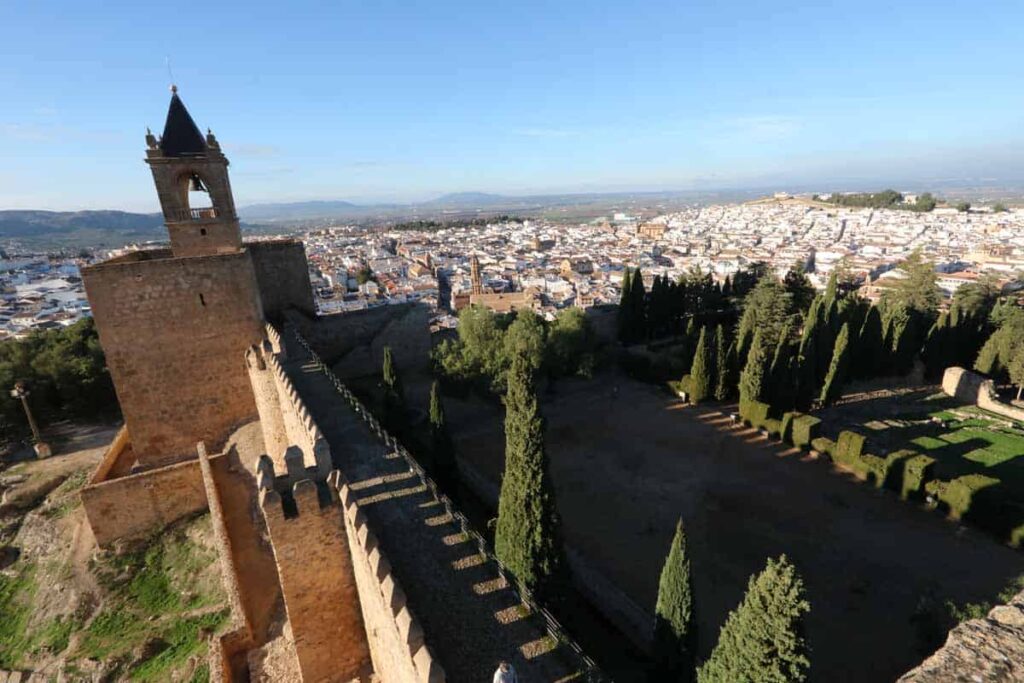

Antequera is a pretty place to discover with some beautiful churches: Iglesia de Nuestra Señora de los Remedios, Iglesia del Carmen and Iglesia San Juan de Dios are our top 3.
Antequera is hilly, with mountains looming behind the city. Lots of great viewpoints. But if there’s one thing you have to do is hike El Torcal de Antequera. It includes some of the most impressive karst geography in Europe.
Antequera can be easily reached from Malaga: the high speed train takes you to Antequera’s AV station in 25 minutes. This tour includes the dolmens and El Torcal – worth it if you don’t have your own wheels.
See this post: A Do-It-Yourself walking tour of Antequera
What are your favorite places on the Costa del Sol?
Related: Why you should visit Zahara de la Sierra
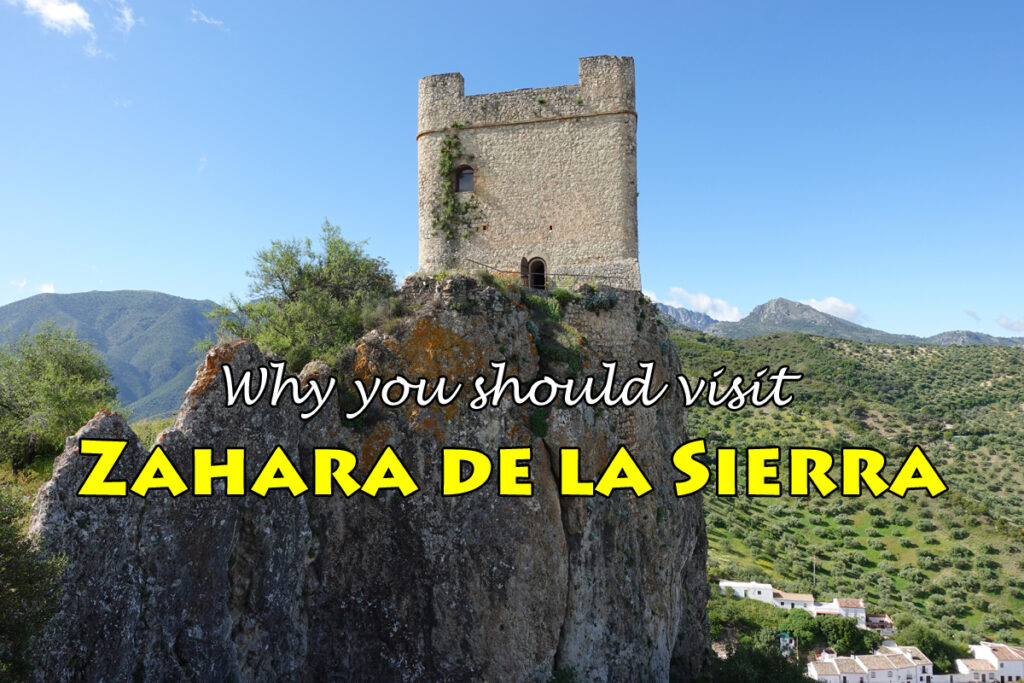
Related: What you need to know about doing the Caminito del Rey
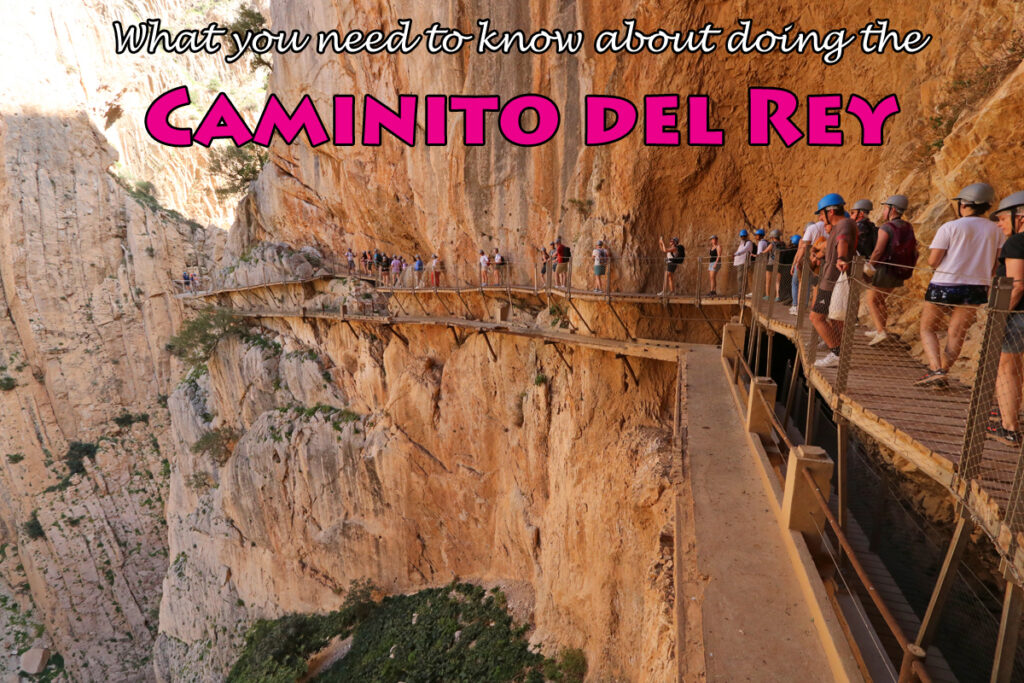

You write so well, I have enjoyed all your reviews and follow your YouTube channel as well! As I am interested in moving to Spain early 2026, everything you write about is being absorbed and noted….I was in Spain April and May this year and have agreed with many of your comments and inside viewpoints, however, there are still a few places you write about that I haven’t visited before, notably the “white Spanish villages” which I look forward to visiting once settled there!
Thank you very much for your comment Childa!
this is exactly what I was looking for. unbiased opinions of these places. The good and the “not so good” thanks so much!
Thank YOU 🙂